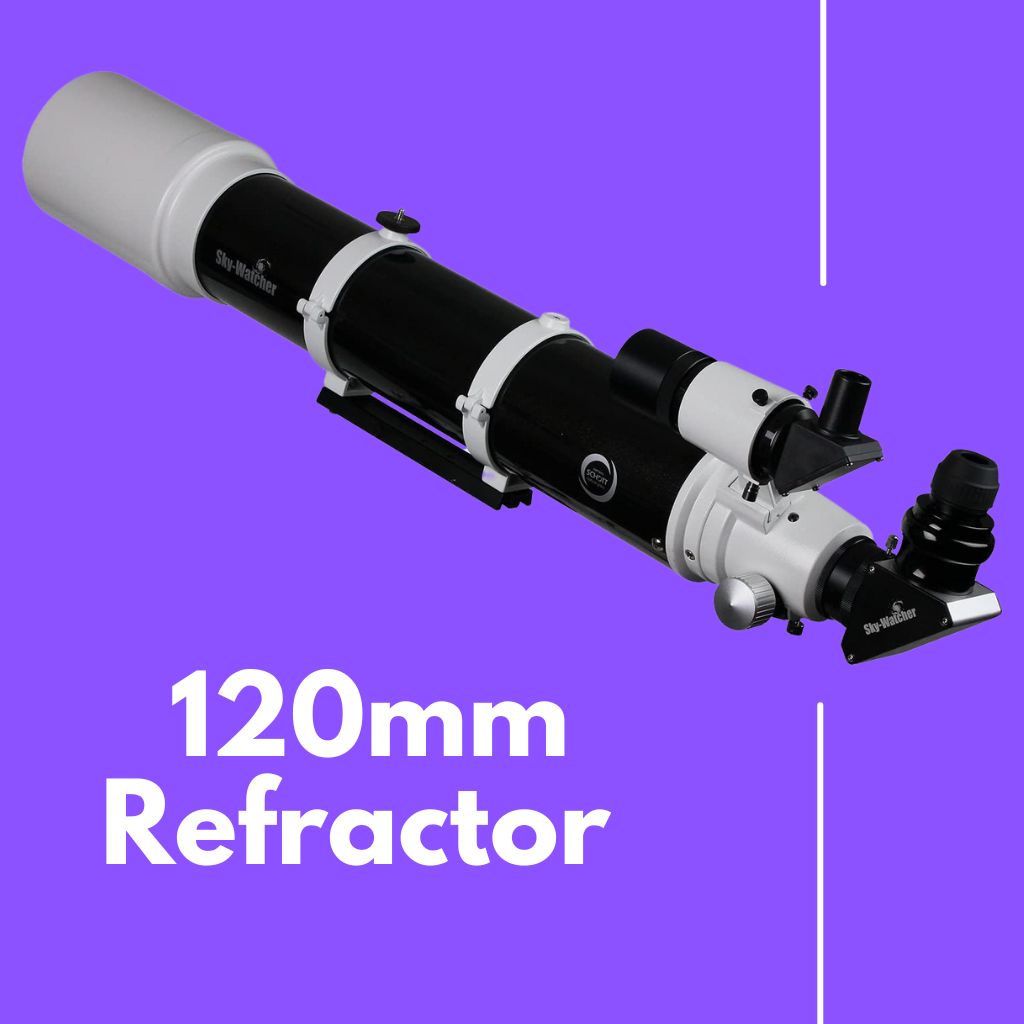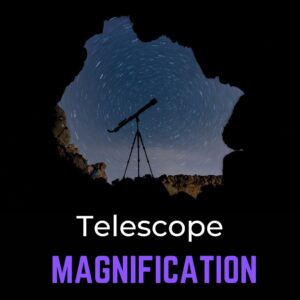This site contains affiliate links to products. I may receive a commission for purchases made through these links.
With a 120mm refractor telescope, you can expect to see a wide range of celestial objects, including the phases of the Moon, Jupiter’s cloud belts, Saturn’s rings, and the red planet Mars.
The telescope’s high optical resolution makes it possible to observe distant galaxies and nebulae in great detail, revealing their intricate structures and stunning colors.
If you’re a stargazing enthusiast and planning to invest in a telescope, a 120mm refractor could be a great choice for you.
Refractor telescopes are known for their ability to produce sharp and clear images, making them an ideal option for viewing the Moon, planets, and deep-sky objects.
In this article, we’ll explore the capabilities of a 120mm refractor telescope and provide a comprehensive guide to the various astronomical objects that you can observe with it.
What to see with a 120mm refractor telescope
Here are some celestial objects you can view with a 120mm refractor telescope:
The Moon
The 120mm refractor telescope is powerful enough to show off the craters, mountains, and valleys on the Moon’s surface in stunning detail.
You can also observe the lunar mare, or dark, flat plains, which are the remnants of ancient volcanic eruptions.
With the right conditions, you may even be able to make out the rays emanating from the craters, providing a glimpse of the Moon’s geological history.
You may also like: 14 Best Telescopes to See the Moon (Ranked!)
The planets
The 120mm refractor telescope is also an excellent choice for observing the planets of our solar system. You can enjoy the views with greater detail.
Jupiter and its four largest moons are fascinating targets, with the telescope’s high resolution allowing for clear views of the planet’s cloud belts and the Galilean moons’ surface details.
Saturn, with its iconic rings, is another exciting target, and the telescope’s high contrast and sharpness provide excellent views of the planet’s ring system.
Mars, with its reddish hue and polar ice caps, is another popular target that can be seen in great detail through a 120mm refractor telescope.
Venus, Mercury, and Uranus can also be viewed with this telescope, although they are typically more challenging to observe due to their smaller size and dimmer appearance.
You may also like: 21 Best Telescopes to See Planets (Read This First!)
Deep sky objects
The 120mm refractor telescope is also a great option for observing deep sky objects
The Orion Nebula, a bright and beautiful object, is a popular target for amateur astronomers using this telescope.
With its rich colors and intricate structures, this nebula is a sight to behold through the 120mm refractor.
Other deep-sky objects that can be observed with this telescope include the Andromeda Galaxy, the Pleiades star cluster, and the Ring Nebula.
You may also like: 9 Best Deep Space Telescopes (Ranked!)
Best 120mm refractor telescopes
If you’re in the market for a new telescope and are considering a 120mm refractor, here are some of the best 120mm refractor telescopes available on the market:
Sky-Watcher Evostar 120 APO Refractor Telescope-Best for astrophotography and visual astronomy
The Sky-Watcher Evostar 120 APO is a premium refractor telescope that boasts a 120mm aperture and an f/7.5 focal ratio. It features a high-quality doublet objective lens and a retractable dew shield, as well as a 2″ dual-speed focuser.
This telescope is ideal for astrophotography, with its apochromatic optics producing clear and sharp images with minimal chromatic aberration.
Sky-Watcher StarTravel 120 Telescope-Best for the moon, planets, and deep sky objects
The Sky-Watcher StarTravel 120 Telescope Portable f/5 is a fantastic option for those looking for a versatile telescope that is easy to transport.
Its 120mm aperture and f/5 focal ratio make it a great choice for both beginners and intermediate astronomers who want to explore the night sky.
The StarTravel 120 features a two-element, air-spaced objective lens that delivers bright, clear, and high-contrast images of the Moon, planets, and deep-sky objects.
Its compact design and lightweight construction make it an excellent choice for traveling or taking it to a remote location for stargazing.
Is a 120mm refractor telescope worth it?
A 120mm refractor telescope has an aperture of 120mm, which means it can gather a good amount of light and provide sharp and detailed views of celestial objects like the Moon, planets, and deep sky objects.
It is a great choice for both beginners and intermediate astronomers who want to explore the night sky.
If you are interested in astronomy and want to explore the night sky with a high-quality and versatile telescope, a 120mm refractor telescope is worth considering.
It can provide excellent views of celestial objects and last for years with proper care and maintenance.
Pros of the 120mm refractor
Here are some of the advantages of a 120mm refractor telescope:
High-quality images
One of the biggest pros of a 120mm refractor is that it can provide high-quality images of celestial objects.
The large aperture of these telescopes allows them to gather more light, which means you can see fainter objects and more detail.
Portable and easy to use
120mm refractors are generally lightweight and compact, making them easy to transport and set up. They don’t require much maintenance, which makes them an excellent choice for beginners.
Versatile for different observing needs
120mm refractors are versatile telescopes that can be used for different observing needs. Whether you’re interested in viewing the Moon, planets, or deep-sky objects, a 120mm refractor can provide excellent views of all three.
Minimal obstruction
Compared to other types of telescopes, refractors have minimal obstruction, meaning there are fewer optical components in the light path.
This leads to better contrast and sharper images, especially for observing planets and other bright objects.
Long lifespan
A 120mm refractors have a long lifespan. Unlike reflector telescopes that require regular maintenance and mirror realignment, refractors have a sealed optical system that can last for decades if properly cared for.
This makes them a great investment for amateur astronomers who want a long-lasting telescope.
Cons of 120mm refractors
Here are some of the cons of 120mm refractor telescopes
Higher cost
One of the biggest cons of a 120mm refractor is that it can be more expensive than other types of telescopes with similar apertures. The cost of a high-quality 120mm refractor can be prohibitive for some beginners or hobbyists.
Chromatic aberration
Another disadvantage of 120mm refractors is the potential for chromatic aberration, especially when viewing bright objects such as the Moon or planets.
Chromatic aberration occurs when different wavelengths of light refract at different angles, causing color fringing and reducing the image’s overall sharpness.
Difficulty in achieving accurate collimation
Like all telescopes, a 120mm refractor requires accurate collimation to ensure optimal performance. However, collimating a refractor can be more challenging than other types of telescopes, especially for beginners.
Potential for dew and frost
Finally, refractors are more prone to dew and frost buildup on the objective lens than other types of telescopes. This can be particularly problematic in humid or cold climates and may require additional equipment or maintenance to prevent.
FAQs about refractor telescopes
Here are the answers to some frequently asked questions about refractor telescopes
What can you see with a refractor telescope?
A refractor telescope can provide detailed views of celestial objects like the Moon, planets, stars, and deep-sky objects such as nebulae and galaxies.
The quality and clarity of the views depend on the aperture size and quality of the optics. Refractor telescopes with larger apertures can gather more light and provide better views of faint objects.
You may also like:
How do I pick a refractor telescope?
When choosing a refractor telescope, consider the aperture size, focal length, optical quality, mount type, portability, and budget.
A larger aperture can provide brighter and more detailed views, while a longer focal length can provide higher magnification.
Optical quality is also important for sharp and clear views. The type of mount can affect stability and ease of use.
Portability can be important if you plan to take your telescope to different locations.
And, of course, your budget can influence your choice of telescope. It’s a good idea to research different models, read reviews, and talk to other astronomers before making a purchase.
What are the best refractor telescopes for viewing planets?
Refractor telescopes with larger apertures and longer focal lengths are generally better for viewing planets.
Some of the best refractor telescopes for planetary observation include:
- Sky-Watcher Evostar 120 APO Refractor Telescope
- Celestron Advanced VX 6 Refractor Telescope
- Orion EON 130mm ED Triplet Apochromatic Refractor Telescope
What can you view with a 102mm refractor telescope?
You can view a variety of celestial objects, including the Moon, planets, star clusters, nebulae, and even some galaxies, with a 102mm refractor telescope.
However, the level of detail and clarity you can achieve may not be as high as with larger telescopes. Fainter deep-sky objects may not be visible or may appear dim and fuzzy. But it is great for viewing the brightest deep sky objects.
The viewing experience can also depend on other factors, such as the observing location and the quality of the telescope itself.
For the best viewing experience, it is recommended to use the telescope in an area with minimal light pollution.
You may also like: What Can You See With an 80mm Refractor? (Answered!)
Is the Skywatcher 120mm AZ3 refractor worth it?
The Skywatcher 120mm AZ3 refractor is a good entry-level telescope for beginners who want to explore the night sky. It has a decent aperture size for bright and detailed views of the Moon, planets, and some deep-sky objects.
The AZ3 mount is easy to use and provides smooth movements. However, the optical quality may not be as good as higher-end refractor telescopes, and the mount may not be stable enough for high-magnification views.
Takeaway: A 120mm refractor telescope is great for viewing the moon, planets, star clusters, and other deep sky objects
A 120mm refractor telescope is an excellent choice for amateur astronomers who want a high-quality viewing experience.
With a 120mm aperture, these telescopes balance portability, affordability, and performance.
They can observe double stars and planetary nebulae due to their fine details and aperture filter.
With minimal light pollution and clear dark skies, the 120mm refractor telescope is great for viewing the brightest and largest objects, including globular clusters and Messier objects.
When choosing a refractor telescope, it’s essential to consider factors such as aperture, focal length, and mount type.
This can ensure that you make an informed decision that meets your observing needs and budget.
You may also like:







